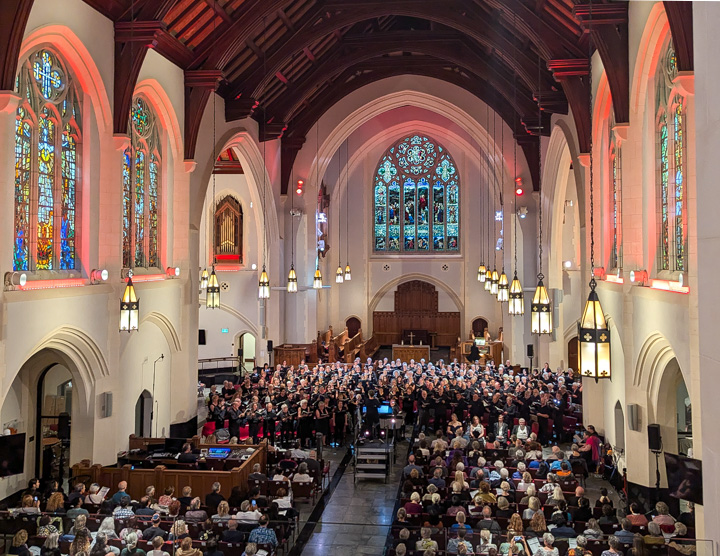
Vancouver has many choirs, with differing proficiency levels and repertoire choices. Most gather fall-to-spring and take the summer off. Thus, Summerchor, which aggregates a couple of hundred singers from many choirs to tackle one of the Really Big choral pieces each August. This year it was the Mozart Requiem. Mozart died while writing this work and there are many “completions” by other composers. Consider just the Modern completions; this performance was of Robert Levin’s.
The 200 singers were assisted by four soloists, a piano, a trombone, the church’s excellent pipe organ, and finally, of course, by the towering arched space.
The combined power of Mozart’s music, the force of massed voices, and the loveliness of the great room yielded a entirely overwhelming torrent of beauty. I felt like my whole body was being squeezed.
Obviously, in an hour-long work, some parts are stronger than others. For me, the opening Requiem Aeternum and Kyrie hit hard, then the absolutely wonderful ascending line opening the Domine Jesu totally crushed me. But for every one of the three-thousand-plus seconds, I was left in no doubt that I was experiencing about as much beauty as a human being can.
God? · We were in a house of worship. The words we were listening to were liturgical, excerpted from Scripture. What, then, of the fact that I am actively hostile to religion? Yeah, I freely acknowledge that all this beauty I’m soaking up is founded on faith. Other people’s faith, of other times. The proportion of people who profess that (or any) faith is monotonically declining, maybe not everywhere, but certainly where I live.
Should I feel sad about that? Not really; The fact that architects and musicians worked for the Church is related to the fact that the Church was willing to pay. Musicians can manage without God, generally, as long as they’re getting paid.
The sound · We’ve been going out to concerts quite a lot recently so of course I’ve been writing about it, and usually discussing the sound quality too.
The sound at the Requiem was beyond awesome. If you look at the picture above you can see there’s a soundboard and a guy sitting at it, but I’m pretty sure the only boost was on the piano, which had to compete with 200 singers and the organ. So, this was the usual classical-music scenario: If you want dynamic range, or to hear soloists, or to blend parts, you do that with musical skill and human throats and fingers and a whole lot of practice. There’s no knob to twirl.
I mean, I love well-executed electric sound, but large-scale classical, done well, is on a whole other level.
Above, I mentioned the rising line at the opening of the Domine Jesu; the pulses, and the space between them, rose up in the endless vertical space as they rose up the scale, and yet were clearly clipped at start and end, because you don’t get that much reverb when the pews are full of soft human flesh and the roof is made of old wood, no matter how big the church is. I just don’t have words for how wonderful it sounded.
Classical? · Obviously, this is what is conventionally called “classical” music. But I’m getting a little less comfortable with that term, especially the connotation that it’s “music for old people” (even though I am one of those). Because so is rootsy rock music and bluegrass and Americana and GoGo Pengin and Guns N’ Roses.
如有侵权请联系:admin#unsafe.sh
